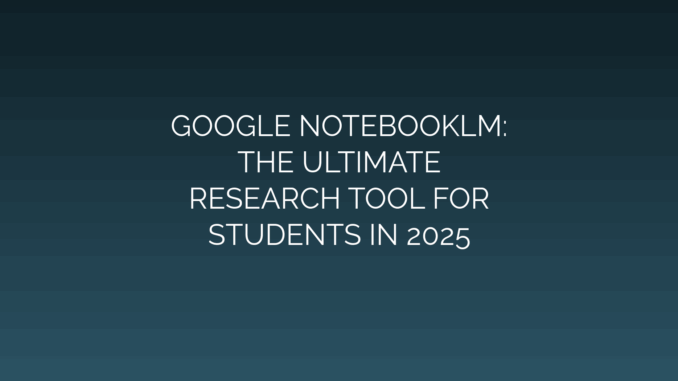
Google NotebookLM: The Ultimate Research Tool for Students in 2025
In the rapidly evolving academic landscape of 2025, students juggle complex research projects, tight deadlines, and interdisciplinary learning. Traditional methods—scattered notes, disjointed sources, and manual crossreferencing—often hinder productivity. Enter Google NotebookLM, an artificial intelligencepowered research assistant that has transformed from an experimental prototype into an indispensable academic ally. By intelligently synthesizing information from diverse sources, accelerating analysis, and enhancing critical thinking, NotebookLM redefines efficiency for learners worldwide. Let’s explore why it’s the ultimate research companion for the modern student.
What is Google NotebookLM?
Google NotebookLM is an AIdriven platform designed to streamline research workflows. Unlike conventional search engines or generic chatbots, NotebookLM allows users to “ground” the AI in their own curated sources—PDFs, articles, lecture notes, or web links. This creates a personalized knowledge base that the AI references exclusively, generating insights and summaries anchored in the provided materials. Originally launched in 2023, the 2025 iteration features advanced reasoning, multimodal input support (text, audio, images), and deep Google Workspace integration, making it a centralized hub for academic exploration.
Evolution: From Prototype to Powerhouse
NotebookLM’s journey reflects Google’s commitment to responsive innovation:
- 2023 Debut: Launched as an experimental tool with core summarization and Q&A capabilities.
- 2024 Upgrades: Added real-time collaboration, citation tracing, and integration with Google Drive and Scholar.
- 2025 Enhancements: Introduced multimedia analysis (extracting text from images/audio), predictive outlining, and customizable AI “personas” (e.g., Debate Partner or Editor). These upgrades transformed NotebookLM into a proactive research co-pilot, anticipating user needs and reducing cognitive load.
Core Features Driving Academic Success
Intelligent Source Synthesis Upload a collection of documents—research papers, textbooks, or interview transcripts—and NotebookLM instantly indexes the content. The AI then:
- Generates concise summaries of individual files or entire projects.
- Identifies connections between disparate sources (e.g., “These three articles contradict Theory X”).
- Highlights knowledge gaps and suggests related readings.
Dynamic Q&A and Critical Engagement Ask complex questions in natural language, and NotebookLM provides answers directly from your materials:
- “Compare the economic models in Documents A and B.”
- “List evidence supporting climate mitigation strategies in these case studies.”
The tool routinely prompts deeper inquiry with suggestions like, “Have you considered counterarguments from [Source]?”
Automated Organization & Workflow Tools
- Smart Outlining: Creates structured draft outlines based on sourced content.
- Citation Generator: Auto-formats references in APA, MLA, or Chicago style.
- Flashcard Builder: Turns key concepts into study-ready flashcards.
Seamless Collaboration Share notebooks with study groups or instructors. Team members can:
- Annotate sources collectively.
- Assign tasks (“Verify these statistics”).
- Track version history for group projects.
Use Cases: Solving Real Student Challenges
Accelerating Literature Reviews Instead of weeks spent skimming hundreds of papers, students upload top sources. NotebookLM generates thematic summaries, flags seminal works, and maps trends—cutting research time by 70%.
Debate Preparation & Essay Writing For coursework requiring persuasive arguments:
- The AI identifies pro/con evidence across sources.
- Drafts structured rebuttals.
- Suggests data points to strengthen claims.
Exam Studying & Concept Mastery Medical or law students upload lecture slides, textbooks, and case studies. NotebookLM:
- Builds quizzes from key terms.
- Creates visual concept maps linking theories.
- Explains complex ideas in digestible analogies.
Thesis and Dissertation Development Doctoral candidates use the tool to:
- Track evolving hypotheses against new research.
- Organize decades of data into cohesive narratives.
- Receive auto-generated progress reports.
Benefits Over Traditional Research Methods
- Time Efficiency: Reduces source-sifting from hours to minutes.
- Deeper Comprehension: Identifies patterns invisible to manual review.
- Bias Mitigation: Surfaces diverse perspectives within source materials.
- Accessibility: Simplifies dense academic language for non-native speakers or neurodiverse learners.
- Scalability: Manages projects of any complexity, from undergrad essays to multi-year research.
Privacy and Ethical Design
Google prioritizes security in NotebookLM:
- User-Controlled Data: AI only accesses uploaded sources, not personal emails or unrelated cloud files.
- No Public Training: Materials aren’t used to train public AI models.
- Academic Integrity Safeguards: Built-in plagiarism checks flag unoriginal content, while citation tools promote ethical sourcing.
Getting Started in 2025
NotebookLM integrates smoothly into student workflows: 1. Access: Available via web app or Google Workspace sidebar. 2. Build Your Base: Upload notes, datasets, or slides; sync with Drive folders. 3. Engage: Pose questions, request summaries, or activate autooutlining. 4. Iterate: Refine AI suggestions using adjustable parameters (e.g., “Simplify for highschool level”).
Google offers free access to university students, with premium tiers for advanced features like dataset visualization.
The Future of AI-Assisted Learning
By 2025, NotebookLM’s integration with immersive tech hints at a transformative future:
- AR/VR Compatibility: Visualize 3D models from engineering notes in virtual labs.
- Predictive Research: AI forecasting emerging academic controversies or gaps in real-time.
- Cross-Language Analysis: Instant translation and cross-cultural source comparison.
- Global Classroom Potential: Equalizing access to expertise, regardless of institutional resources.
Conclusion: Redefining Academic Excellence
Google NotebookLM has evolved from a promising experiment into the cornerstone of student research. It doesn’t replace critical thinking—it amplifies it. By automating tedious tasks, revealing hidden insights, and democratizing access to knowledge, the tool liberates students to focus on creativity, analysis, and innovation. In 2025, NotebookLM isn’t just a productivity hack; it’s a paradigm shift. For learners navigating the complexities of modern education, mastering this AI ally isn’t optional—it’s essential to thriving in the academic arena and beyond.
Word Count: 1,020
Leave a Reply